Business Environment Report: Red Cross and Business Factors
VerifiedAdded on 2020/10/22
|21
|6840
|225
Report
AI Summary
This report provides a comprehensive analysis of the business environment, focusing on different types of organizations including public, private, and voluntary sectors, along with their legal structures, sizes, and scopes. It examines the relationship between various organizational functions such as marketing, finance, human resources, and operations, linking them to the overall objectives and structure of a business. The report also delves into the positive and negative impacts of the macro environment on business operations and conducts internal and external analyses to identify strengths and weaknesses, particularly focusing on the British Red Cross. The study explores how internal and external factors interrelate and affect the strengths and weaknesses of the Red Cross, concluding with a summary of the key findings and their implications for business strategy and performance.
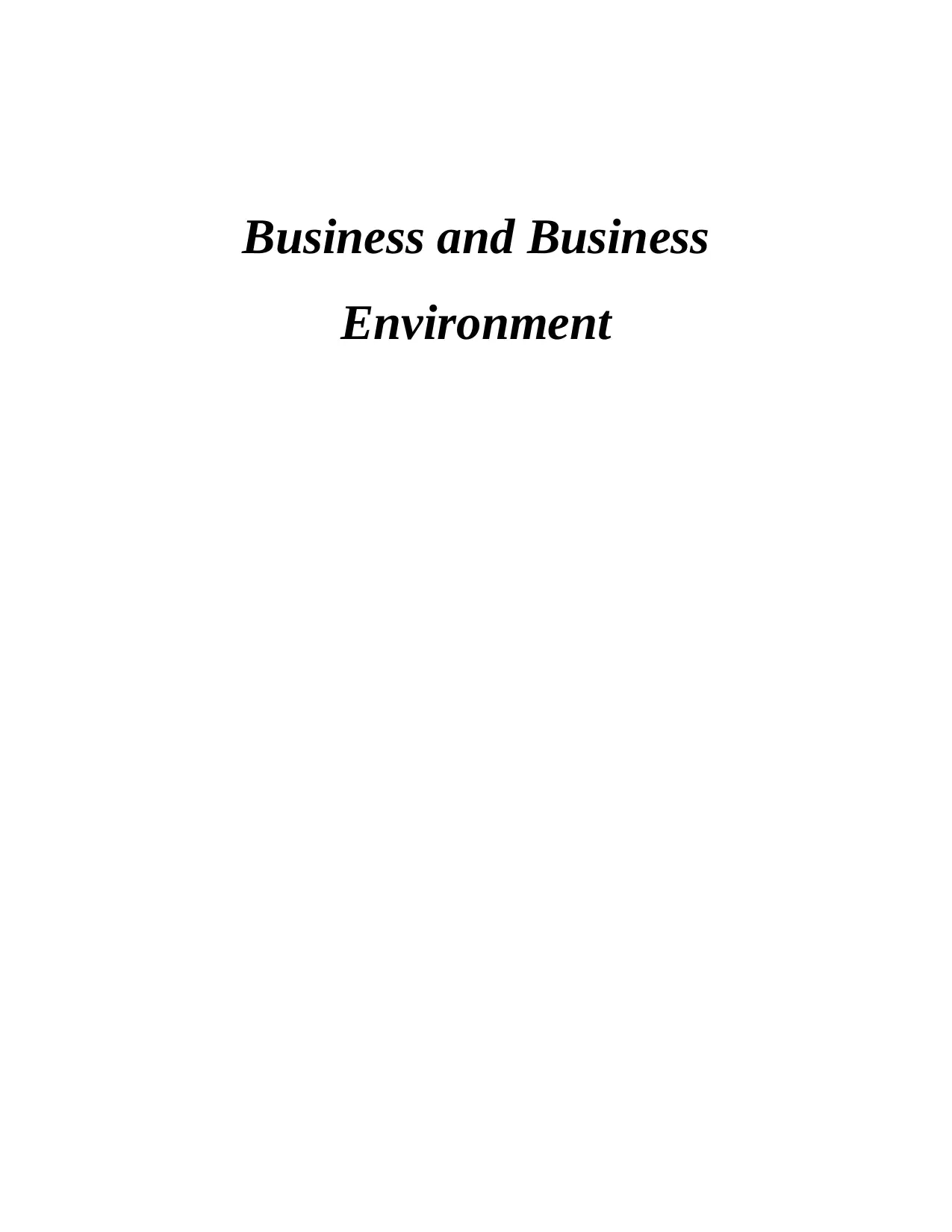
Business and Business
Environment
Environment
Paraphrase This Document
Need a fresh take? Get an instant paraphrase of this document with our AI Paraphraser
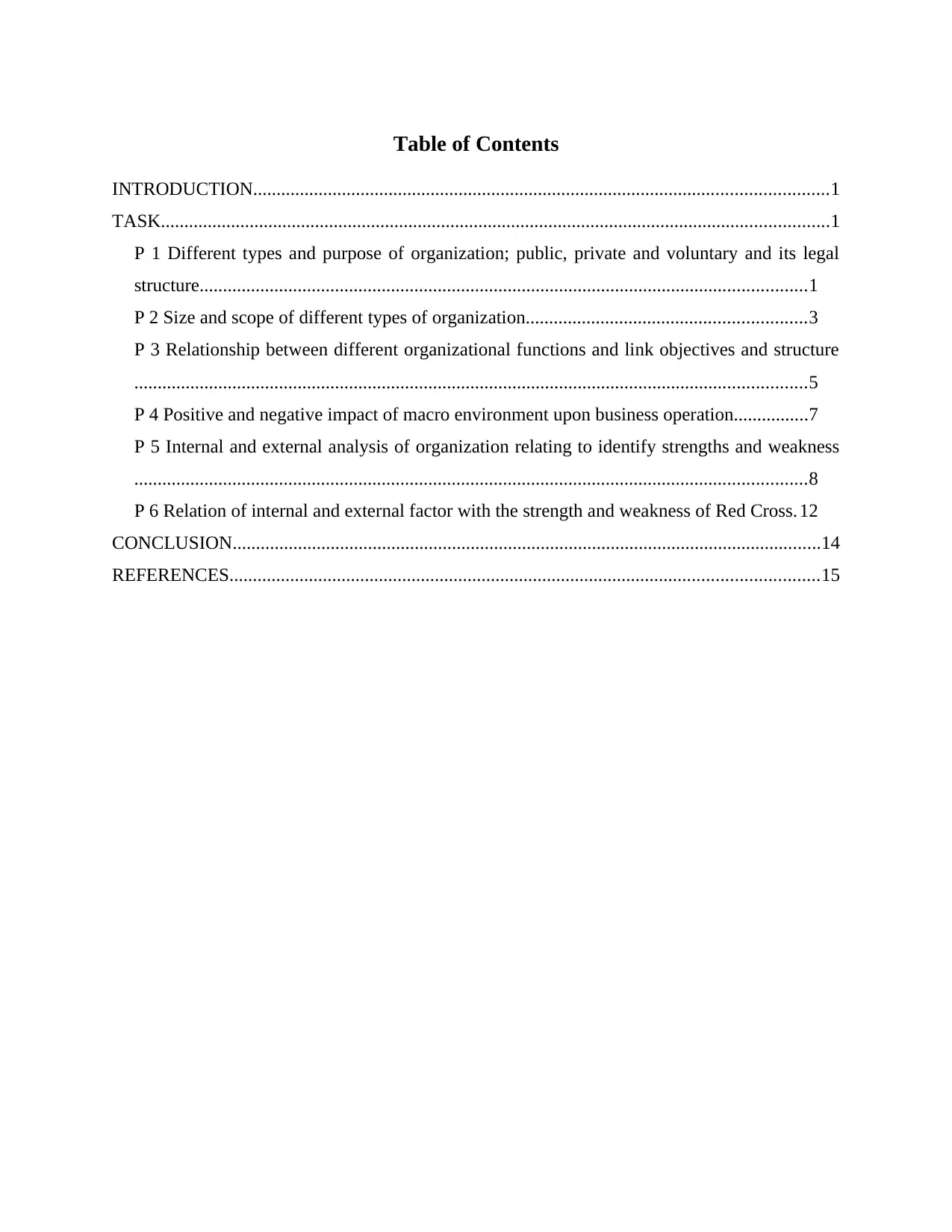
Table of Contents
INTRODUCTION...........................................................................................................................1
TASK...............................................................................................................................................1
P 1 Different types and purpose of organization; public, private and voluntary and its legal
structure..................................................................................................................................1
P 2 Size and scope of different types of organization............................................................3
P 3 Relationship between different organizational functions and link objectives and structure
................................................................................................................................................5
P 4 Positive and negative impact of macro environment upon business operation................7
P 5 Internal and external analysis of organization relating to identify strengths and weakness
................................................................................................................................................8
P 6 Relation of internal and external factor with the strength and weakness of Red Cross. 12
CONCLUSION..............................................................................................................................14
REFERENCES..............................................................................................................................15
INTRODUCTION...........................................................................................................................1
TASK...............................................................................................................................................1
P 1 Different types and purpose of organization; public, private and voluntary and its legal
structure..................................................................................................................................1
P 2 Size and scope of different types of organization............................................................3
P 3 Relationship between different organizational functions and link objectives and structure
................................................................................................................................................5
P 4 Positive and negative impact of macro environment upon business operation................7
P 5 Internal and external analysis of organization relating to identify strengths and weakness
................................................................................................................................................8
P 6 Relation of internal and external factor with the strength and weakness of Red Cross. 12
CONCLUSION..............................................................................................................................14
REFERENCES..............................................................................................................................15

INTRODUCTION
Business environment is total of single person, organization and other units that are in
external control of company but organization still depends upon them as they affect overall
activities and sustainability of business (Van der Voet, 2014). It is helping for analysis
opportunities, improving overall performance of firm.
This report is based on British Red Cross society. It is UK body of worldwide neutral and
impartial humanitarian network which is helping people without discrimination. This assignment
explains different types, purpose and legal structures of organization. It assesses size and scope
of various entities. It states relationship between organizational function and link to objectives
and structure. Identifies positive and negative impacts macro environment has upon operations of
business. Conducts internal and external analysis of organisation in order to identify strengths
and weakness. Explains pros and cons interrelate with external macro factors.
TASK
P 1 Different types and purpose of organization; public, private and voluntary and its legal
structure
Introduction:
This particular section will be dealing with the public, private and voluntary with
providing its legal sector. The part includes types and purpose of organisations so that difference
would be discussed following with example and definition of each of the organisation as well.
Public sector organization:
Public sector is the part of economy composed of both public services and enterprises.
General services are included public goods and government facilities such as police, military,
transit, education etc. This sector is providing services that non payer cannot exclude from
facilities which benefits all of society. For example: Super dry is public organization which is
dealing in clothing brand.
Purpose:
The aim of Public Sector Company is to provide crucial services to poor and large section
of society (Zhang, Welch and Miao, 2018).
Public sector is increasing job, income and employment.
It supplies of goods to public smoothly.
Legal structure:
1
Business environment is total of single person, organization and other units that are in
external control of company but organization still depends upon them as they affect overall
activities and sustainability of business (Van der Voet, 2014). It is helping for analysis
opportunities, improving overall performance of firm.
This report is based on British Red Cross society. It is UK body of worldwide neutral and
impartial humanitarian network which is helping people without discrimination. This assignment
explains different types, purpose and legal structures of organization. It assesses size and scope
of various entities. It states relationship between organizational function and link to objectives
and structure. Identifies positive and negative impacts macro environment has upon operations of
business. Conducts internal and external analysis of organisation in order to identify strengths
and weakness. Explains pros and cons interrelate with external macro factors.
TASK
P 1 Different types and purpose of organization; public, private and voluntary and its legal
structure
Introduction:
This particular section will be dealing with the public, private and voluntary with
providing its legal sector. The part includes types and purpose of organisations so that difference
would be discussed following with example and definition of each of the organisation as well.
Public sector organization:
Public sector is the part of economy composed of both public services and enterprises.
General services are included public goods and government facilities such as police, military,
transit, education etc. This sector is providing services that non payer cannot exclude from
facilities which benefits all of society. For example: Super dry is public organization which is
dealing in clothing brand.
Purpose:
The aim of Public Sector Company is to provide crucial services to poor and large section
of society (Zhang, Welch and Miao, 2018).
Public sector is increasing job, income and employment.
It supplies of goods to public smoothly.
Legal structure:
1
⊘ This is a preview!⊘
Do you want full access?
Subscribe today to unlock all pages.

Trusted by 1+ million students worldwide
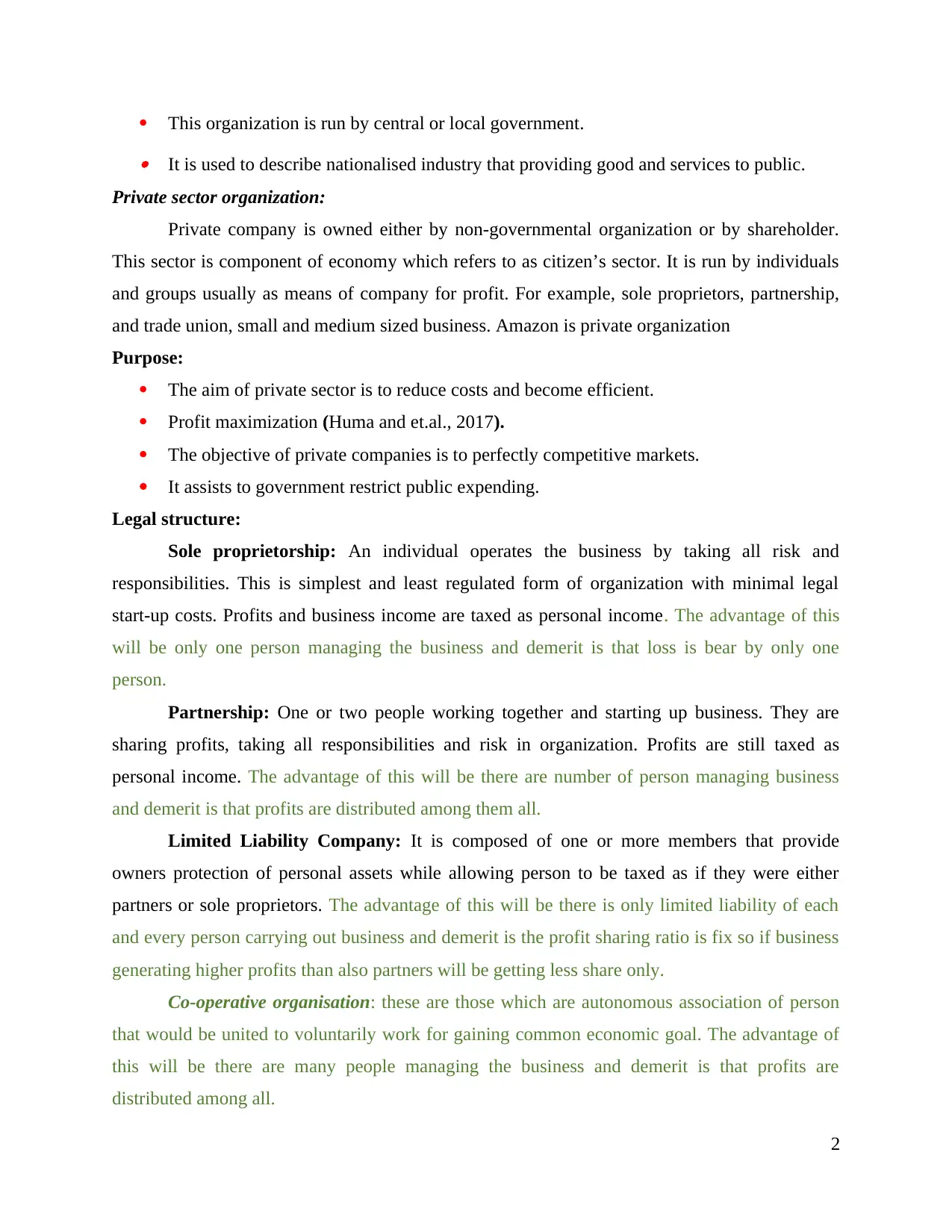
This organization is run by central or local government. It is used to describe nationalised industry that providing good and services to public.
Private sector organization:
Private company is owned either by non-governmental organization or by shareholder.
This sector is component of economy which refers to as citizen’s sector. It is run by individuals
and groups usually as means of company for profit. For example, sole proprietors, partnership,
and trade union, small and medium sized business. Amazon is private organization
Purpose:
The aim of private sector is to reduce costs and become efficient.
Profit maximization (Huma and et.al., 2017).
The objective of private companies is to perfectly competitive markets.
It assists to government restrict public expending.
Legal structure:
Sole proprietorship: An individual operates the business by taking all risk and
responsibilities. This is simplest and least regulated form of organization with minimal legal
start-up costs. Profits and business income are taxed as personal income. The advantage of this
will be only one person managing the business and demerit is that loss is bear by only one
person.
Partnership: One or two people working together and starting up business. They are
sharing profits, taking all responsibilities and risk in organization. Profits are still taxed as
personal income. The advantage of this will be there are number of person managing business
and demerit is that profits are distributed among them all.
Limited Liability Company: It is composed of one or more members that provide
owners protection of personal assets while allowing person to be taxed as if they were either
partners or sole proprietors. The advantage of this will be there is only limited liability of each
and every person carrying out business and demerit is the profit sharing ratio is fix so if business
generating higher profits than also partners will be getting less share only.
Co-operative organisation: these are those which are autonomous association of person
that would be united to voluntarily work for gaining common economic goal. The advantage of
this will be there are many people managing the business and demerit is that profits are
distributed among all.
2
Private sector organization:
Private company is owned either by non-governmental organization or by shareholder.
This sector is component of economy which refers to as citizen’s sector. It is run by individuals
and groups usually as means of company for profit. For example, sole proprietors, partnership,
and trade union, small and medium sized business. Amazon is private organization
Purpose:
The aim of private sector is to reduce costs and become efficient.
Profit maximization (Huma and et.al., 2017).
The objective of private companies is to perfectly competitive markets.
It assists to government restrict public expending.
Legal structure:
Sole proprietorship: An individual operates the business by taking all risk and
responsibilities. This is simplest and least regulated form of organization with minimal legal
start-up costs. Profits and business income are taxed as personal income. The advantage of this
will be only one person managing the business and demerit is that loss is bear by only one
person.
Partnership: One or two people working together and starting up business. They are
sharing profits, taking all responsibilities and risk in organization. Profits are still taxed as
personal income. The advantage of this will be there are number of person managing business
and demerit is that profits are distributed among them all.
Limited Liability Company: It is composed of one or more members that provide
owners protection of personal assets while allowing person to be taxed as if they were either
partners or sole proprietors. The advantage of this will be there is only limited liability of each
and every person carrying out business and demerit is the profit sharing ratio is fix so if business
generating higher profits than also partners will be getting less share only.
Co-operative organisation: these are those which are autonomous association of person
that would be united to voluntarily work for gaining common economic goal. The advantage of
this will be there are many people managing the business and demerit is that profits are
distributed among all.
2
Paraphrase This Document
Need a fresh take? Get an instant paraphrase of this document with our AI Paraphraser
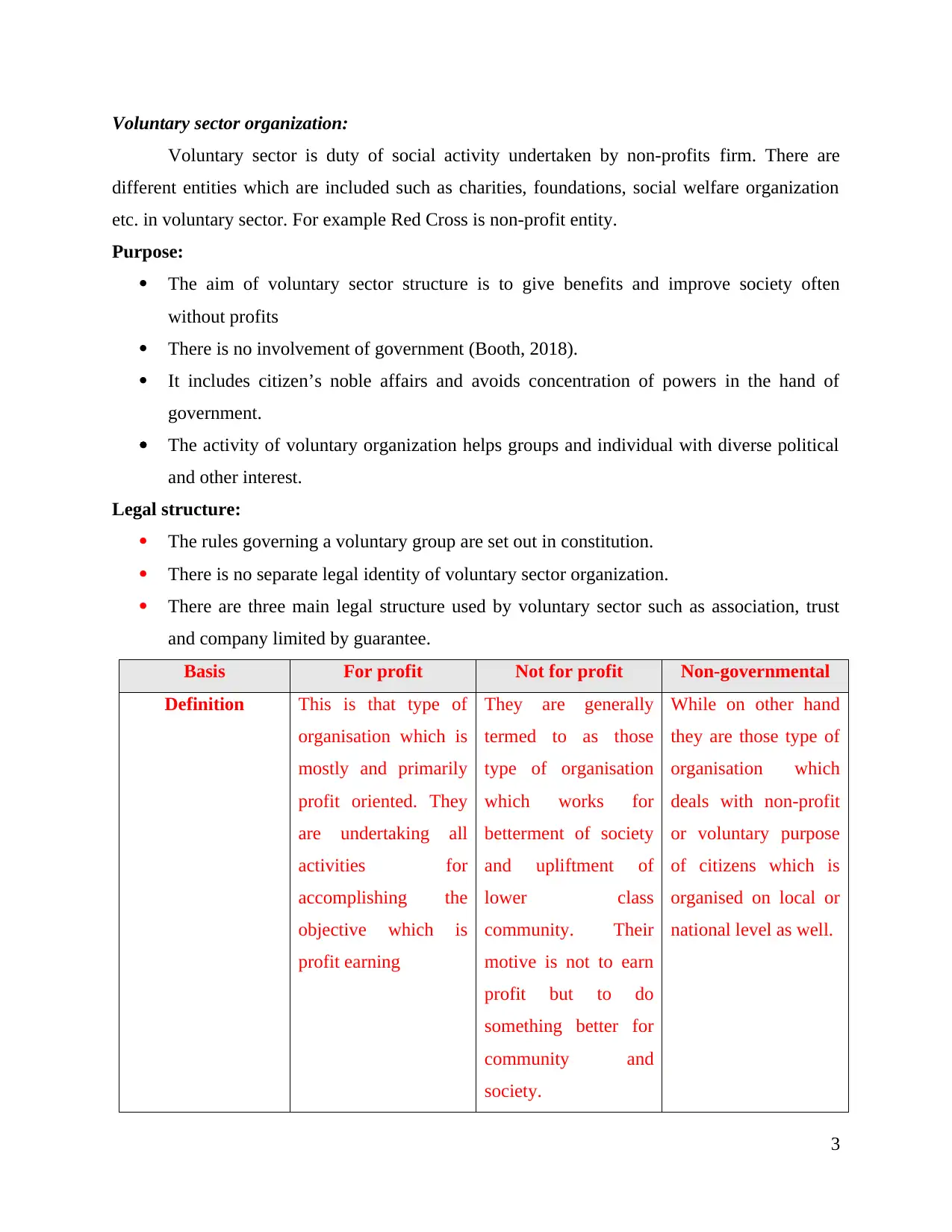
Voluntary sector organization:
Voluntary sector is duty of social activity undertaken by non-profits firm. There are
different entities which are included such as charities, foundations, social welfare organization
etc. in voluntary sector. For example Red Cross is non-profit entity.
Purpose:
The aim of voluntary sector structure is to give benefits and improve society often
without profits
There is no involvement of government (Booth, 2018).
It includes citizen’s noble affairs and avoids concentration of powers in the hand of
government.
The activity of voluntary organization helps groups and individual with diverse political
and other interest.
Legal structure:
The rules governing a voluntary group are set out in constitution.
There is no separate legal identity of voluntary sector organization.
There are three main legal structure used by voluntary sector such as association, trust
and company limited by guarantee.
Basis For profit Not for profit Non-governmental
Definition This is that type of
organisation which is
mostly and primarily
profit oriented. They
are undertaking all
activities for
accomplishing the
objective which is
profit earning
They are generally
termed to as those
type of organisation
which works for
betterment of society
and upliftment of
lower class
community. Their
motive is not to earn
profit but to do
something better for
community and
society.
While on other hand
they are those type of
organisation which
deals with non-profit
or voluntary purpose
of citizens which is
organised on local or
national level as well.
3
Voluntary sector is duty of social activity undertaken by non-profits firm. There are
different entities which are included such as charities, foundations, social welfare organization
etc. in voluntary sector. For example Red Cross is non-profit entity.
Purpose:
The aim of voluntary sector structure is to give benefits and improve society often
without profits
There is no involvement of government (Booth, 2018).
It includes citizen’s noble affairs and avoids concentration of powers in the hand of
government.
The activity of voluntary organization helps groups and individual with diverse political
and other interest.
Legal structure:
The rules governing a voluntary group are set out in constitution.
There is no separate legal identity of voluntary sector organization.
There are three main legal structure used by voluntary sector such as association, trust
and company limited by guarantee.
Basis For profit Not for profit Non-governmental
Definition This is that type of
organisation which is
mostly and primarily
profit oriented. They
are undertaking all
activities for
accomplishing the
objective which is
profit earning
They are generally
termed to as those
type of organisation
which works for
betterment of society
and upliftment of
lower class
community. Their
motive is not to earn
profit but to do
something better for
community and
society.
While on other hand
they are those type of
organisation which
deals with non-profit
or voluntary purpose
of citizens which is
organised on local or
national level as well.
3

Source of fund Their source of funds
is mainly their profits
and revenue earned by
company.
If they are earning any
sort of income then it
is again returned back
to their organisation if
they are generating
any extra income.
Their source of fund
is from society and
community only
Example Marks and Spencer American Red Cross,
Oxfam
International
Federation of Red
Cross and Red
Crescent Societies
Conclusion:
From the above section it could be concluded that there are 3 types of organisation
venture which are public, private and volunteer and all of them are following their own legal
structure. All of these could be distinguish based on their legal structure like that of sole trader,
partnership and cooperatives as well.
P 2 Size and scope of different types of organization
Introduction:
This particular section will be covering size and scope of various types of different of
organisation. This will explain the different type of organisation that is based on their size which
is like that of Small, Medium, and Large. The further more possible differences between
objectives of these four types of organisations Micro, Small, Medium, and Large will be done.
The public organisation is having the purpose of generating employment and ultimately lead to
profits while that of private company is to generate higher number of revenues and that of
voluntary is to provide service to public.
There are three types of organization such private, public and voluntary. In order to that,
all companies have different purpose, size and scope.
Criteria Private organization Public Organization Voluntary
Organization
Purpose The aim of private The purpose of public firm The goal of voluntary
4
is mainly their profits
and revenue earned by
company.
If they are earning any
sort of income then it
is again returned back
to their organisation if
they are generating
any extra income.
Their source of fund
is from society and
community only
Example Marks and Spencer American Red Cross,
Oxfam
International
Federation of Red
Cross and Red
Crescent Societies
Conclusion:
From the above section it could be concluded that there are 3 types of organisation
venture which are public, private and volunteer and all of them are following their own legal
structure. All of these could be distinguish based on their legal structure like that of sole trader,
partnership and cooperatives as well.
P 2 Size and scope of different types of organization
Introduction:
This particular section will be covering size and scope of various types of different of
organisation. This will explain the different type of organisation that is based on their size which
is like that of Small, Medium, and Large. The further more possible differences between
objectives of these four types of organisations Micro, Small, Medium, and Large will be done.
The public organisation is having the purpose of generating employment and ultimately lead to
profits while that of private company is to generate higher number of revenues and that of
voluntary is to provide service to public.
There are three types of organization such private, public and voluntary. In order to that,
all companies have different purpose, size and scope.
Criteria Private organization Public Organization Voluntary
Organization
Purpose The aim of private The purpose of public firm The goal of voluntary
4
⊘ This is a preview!⊘
Do you want full access?
Subscribe today to unlock all pages.

Trusted by 1+ million students worldwide
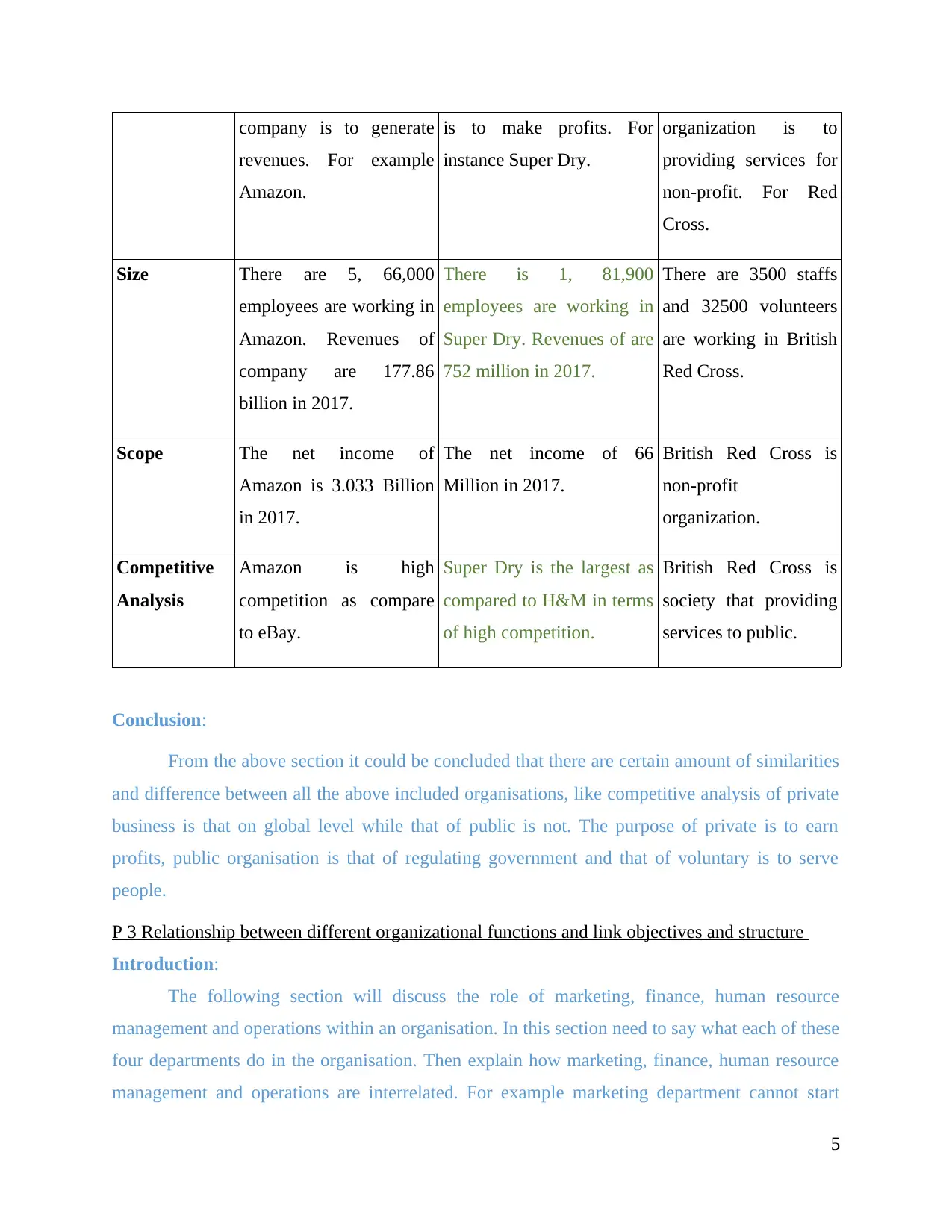
company is to generate
revenues. For example
Amazon.
is to make profits. For
instance Super Dry.
organization is to
providing services for
non-profit. For Red
Cross.
Size There are 5, 66,000
employees are working in
Amazon. Revenues of
company are 177.86
billion in 2017.
There is 1, 81,900
employees are working in
Super Dry. Revenues of are
752 million in 2017.
There are 3500 staffs
and 32500 volunteers
are working in British
Red Cross.
Scope The net income of
Amazon is 3.033 Billion
in 2017.
The net income of 66
Million in 2017.
British Red Cross is
non-profit
organization.
Competitive
Analysis
Amazon is high
competition as compare
to eBay.
Super Dry is the largest as
compared to H&M in terms
of high competition.
British Red Cross is
society that providing
services to public.
Conclusion:
From the above section it could be concluded that there are certain amount of similarities
and difference between all the above included organisations, like competitive analysis of private
business is that on global level while that of public is not. The purpose of private is to earn
profits, public organisation is that of regulating government and that of voluntary is to serve
people.
P 3 Relationship between different organizational functions and link objectives and structure
Introduction:
The following section will discuss the role of marketing, finance, human resource
management and operations within an organisation. In this section need to say what each of these
four departments do in the organisation. Then explain how marketing, finance, human resource
management and operations are interrelated. For example marketing department cannot start
5
revenues. For example
Amazon.
is to make profits. For
instance Super Dry.
organization is to
providing services for
non-profit. For Red
Cross.
Size There are 5, 66,000
employees are working in
Amazon. Revenues of
company are 177.86
billion in 2017.
There is 1, 81,900
employees are working in
Super Dry. Revenues of are
752 million in 2017.
There are 3500 staffs
and 32500 volunteers
are working in British
Red Cross.
Scope The net income of
Amazon is 3.033 Billion
in 2017.
The net income of 66
Million in 2017.
British Red Cross is
non-profit
organization.
Competitive
Analysis
Amazon is high
competition as compare
to eBay.
Super Dry is the largest as
compared to H&M in terms
of high competition.
British Red Cross is
society that providing
services to public.
Conclusion:
From the above section it could be concluded that there are certain amount of similarities
and difference between all the above included organisations, like competitive analysis of private
business is that on global level while that of public is not. The purpose of private is to earn
profits, public organisation is that of regulating government and that of voluntary is to serve
people.
P 3 Relationship between different organizational functions and link objectives and structure
Introduction:
The following section will discuss the role of marketing, finance, human resource
management and operations within an organisation. In this section need to say what each of these
four departments do in the organisation. Then explain how marketing, finance, human resource
management and operations are interrelated. For example marketing department cannot start
5
Paraphrase This Document
Need a fresh take? Get an instant paraphrase of this document with our AI Paraphraser
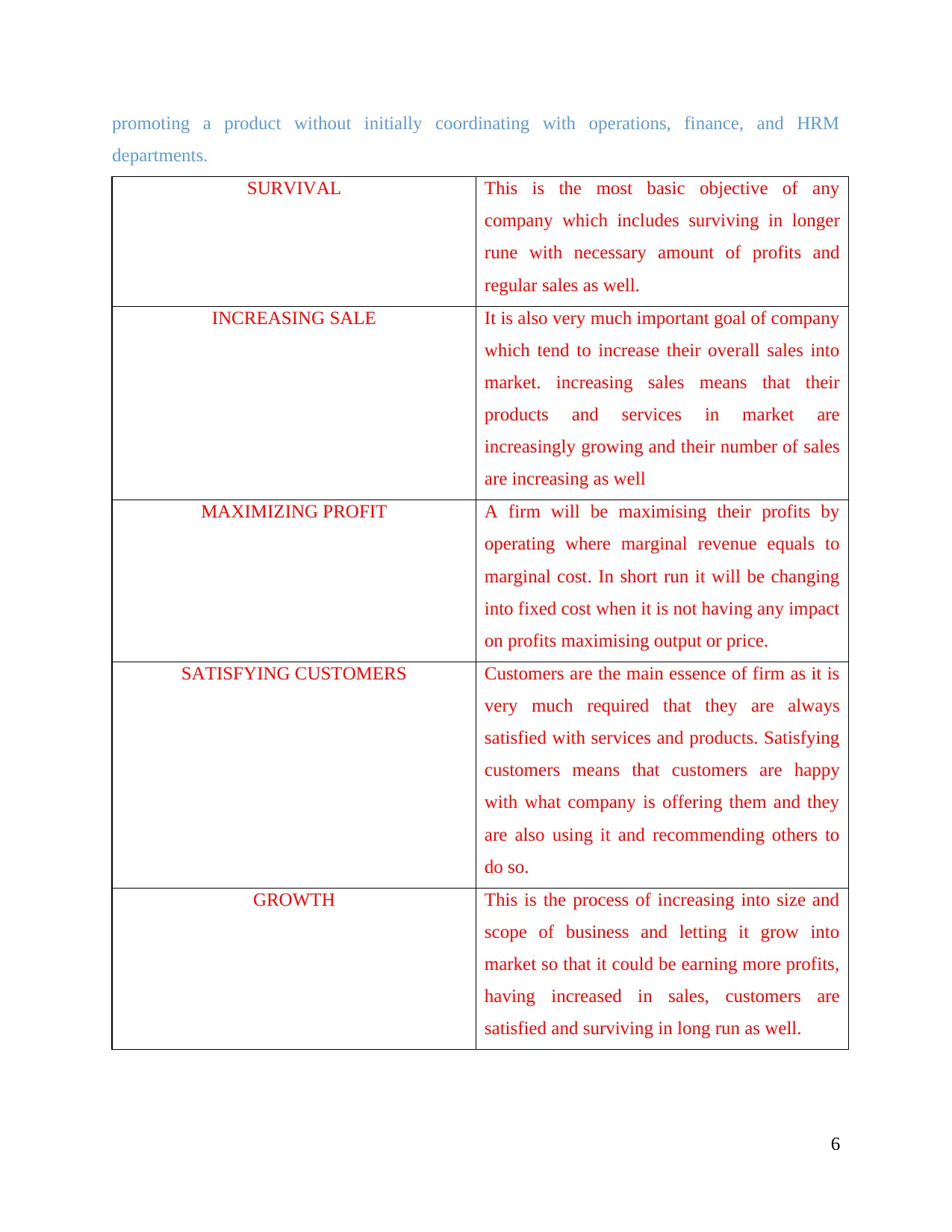
promoting a product without initially coordinating with operations, finance, and HRM
departments.
SURVIVAL This is the most basic objective of any
company which includes surviving in longer
rune with necessary amount of profits and
regular sales as well.
INCREASING SALE It is also very much important goal of company
which tend to increase their overall sales into
market. increasing sales means that their
products and services in market are
increasingly growing and their number of sales
are increasing as well
MAXIMIZING PROFIT A firm will be maximising their profits by
operating where marginal revenue equals to
marginal cost. In short run it will be changing
into fixed cost when it is not having any impact
on profits maximising output or price.
SATISFYING CUSTOMERS Customers are the main essence of firm as it is
very much required that they are always
satisfied with services and products. Satisfying
customers means that customers are happy
with what company is offering them and they
are also using it and recommending others to
do so.
GROWTH This is the process of increasing into size and
scope of business and letting it grow into
market so that it could be earning more profits,
having increased in sales, customers are
satisfied and surviving in long run as well.
6
departments.
SURVIVAL This is the most basic objective of any
company which includes surviving in longer
rune with necessary amount of profits and
regular sales as well.
INCREASING SALE It is also very much important goal of company
which tend to increase their overall sales into
market. increasing sales means that their
products and services in market are
increasingly growing and their number of sales
are increasing as well
MAXIMIZING PROFIT A firm will be maximising their profits by
operating where marginal revenue equals to
marginal cost. In short run it will be changing
into fixed cost when it is not having any impact
on profits maximising output or price.
SATISFYING CUSTOMERS Customers are the main essence of firm as it is
very much required that they are always
satisfied with services and products. Satisfying
customers means that customers are happy
with what company is offering them and they
are also using it and recommending others to
do so.
GROWTH This is the process of increasing into size and
scope of business and letting it grow into
market so that it could be earning more profits,
having increased in sales, customers are
satisfied and surviving in long run as well.
6

The goals of BRC are to provide the best facilities such as social care, health and safety,
education etc. In order to do that, there are various functions of organization such as marketing,
human resources, finance, administrative etc. which are performed in effective manner. All
activities are linked with objectives and structure of company. Company follows flat
organizational structure (Flat organizational Structure, 2018).
Marketing Functions: There are different activities including this section such as market
information, products designing, development and marketing planning etc. So that, manager
discusses with human resource department for selecting the best candidates for marketing
purpose. They are also considering finance department for managing funds relating to
advertisement, products designing, branding and other activities (Liddle, 2014). With the help of
this function, Red Cross is providing the best facilities to people. Marketing function assists in
achieving goals and objective of company. Society follows flat structure of organization, so that
it is easy to interact with staff and department. By marketing activities, company is increasing
productivity of products and services in front of public. Marketing function will be helping
company in achieving objectives like that of allowing company to survive through competition,
increasing number of sales, increasing profits and satisfying customers as well.
Human Resource Functions: There are many activities that are involved in this
department such as recruitment and selection, training and development, employee’s benefits,
worker relation and legal responsibilities. HR manager consults with finance for arranging funds
for advertising jobs and selecting the best candidate at workplace. With help of the best
7
Illustration 1: Flat organizational structure
Source: (Flat organizational Structure, 2018)
education etc. In order to do that, there are various functions of organization such as marketing,
human resources, finance, administrative etc. which are performed in effective manner. All
activities are linked with objectives and structure of company. Company follows flat
organizational structure (Flat organizational Structure, 2018).
Marketing Functions: There are different activities including this section such as market
information, products designing, development and marketing planning etc. So that, manager
discusses with human resource department for selecting the best candidates for marketing
purpose. They are also considering finance department for managing funds relating to
advertisement, products designing, branding and other activities (Liddle, 2014). With the help of
this function, Red Cross is providing the best facilities to people. Marketing function assists in
achieving goals and objective of company. Society follows flat structure of organization, so that
it is easy to interact with staff and department. By marketing activities, company is increasing
productivity of products and services in front of public. Marketing function will be helping
company in achieving objectives like that of allowing company to survive through competition,
increasing number of sales, increasing profits and satisfying customers as well.
Human Resource Functions: There are many activities that are involved in this
department such as recruitment and selection, training and development, employee’s benefits,
worker relation and legal responsibilities. HR manager consults with finance for arranging funds
for advertising jobs and selecting the best candidate at workplace. With help of the best
7
Illustration 1: Flat organizational structure
Source: (Flat organizational Structure, 2018)
⊘ This is a preview!⊘
Do you want full access?
Subscribe today to unlock all pages.

Trusted by 1+ million students worldwide
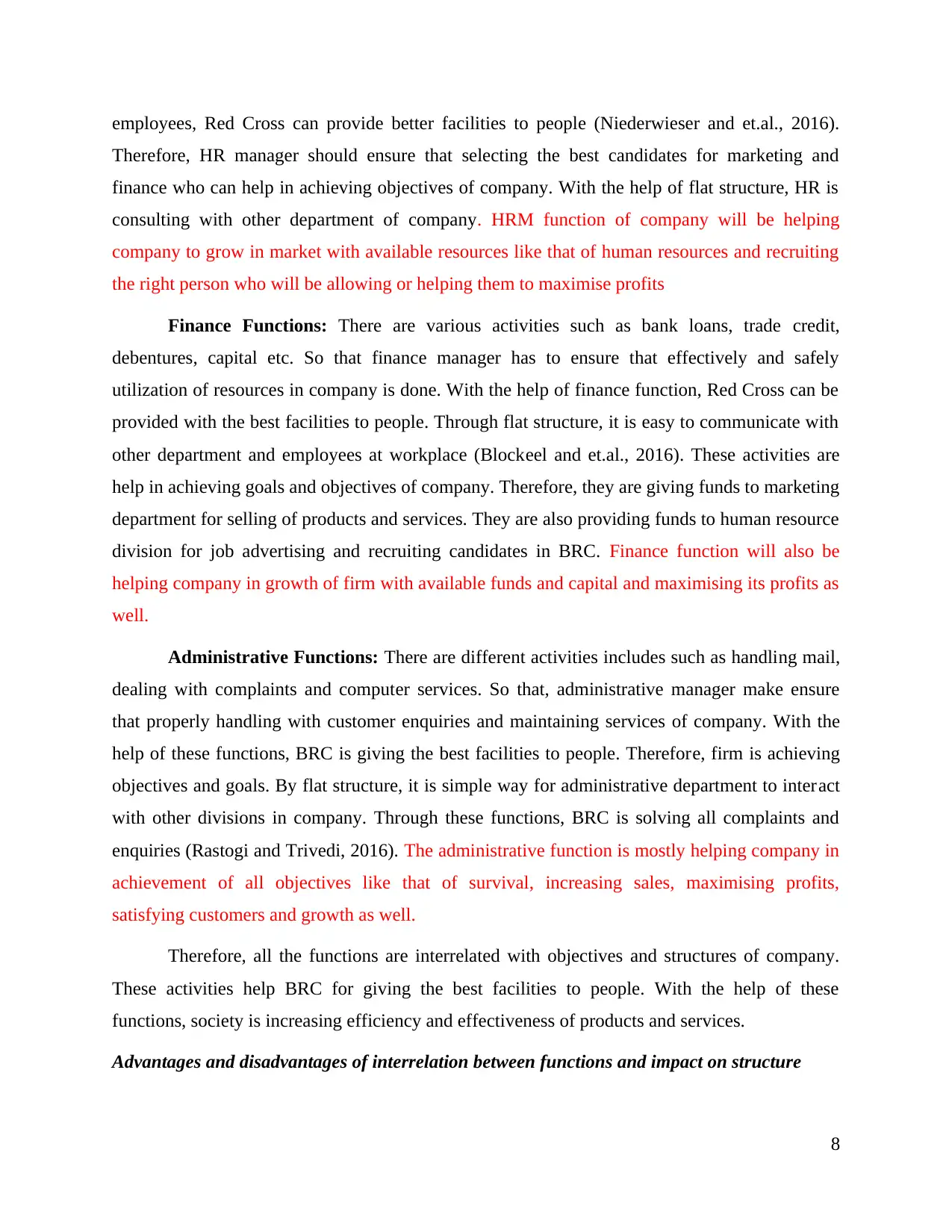
employees, Red Cross can provide better facilities to people (Niederwieser and et.al., 2016).
Therefore, HR manager should ensure that selecting the best candidates for marketing and
finance who can help in achieving objectives of company. With the help of flat structure, HR is
consulting with other department of company. HRM function of company will be helping
company to grow in market with available resources like that of human resources and recruiting
the right person who will be allowing or helping them to maximise profits
Finance Functions: There are various activities such as bank loans, trade credit,
debentures, capital etc. So that finance manager has to ensure that effectively and safely
utilization of resources in company is done. With the help of finance function, Red Cross can be
provided with the best facilities to people. Through flat structure, it is easy to communicate with
other department and employees at workplace (Blockeel and et.al., 2016). These activities are
help in achieving goals and objectives of company. Therefore, they are giving funds to marketing
department for selling of products and services. They are also providing funds to human resource
division for job advertising and recruiting candidates in BRC. Finance function will also be
helping company in growth of firm with available funds and capital and maximising its profits as
well.
Administrative Functions: There are different activities includes such as handling mail,
dealing with complaints and computer services. So that, administrative manager make ensure
that properly handling with customer enquiries and maintaining services of company. With the
help of these functions, BRC is giving the best facilities to people. Therefore, firm is achieving
objectives and goals. By flat structure, it is simple way for administrative department to interact
with other divisions in company. Through these functions, BRC is solving all complaints and
enquiries (Rastogi and Trivedi, 2016). The administrative function is mostly helping company in
achievement of all objectives like that of survival, increasing sales, maximising profits,
satisfying customers and growth as well.
Therefore, all the functions are interrelated with objectives and structures of company.
These activities help BRC for giving the best facilities to people. With the help of these
functions, society is increasing efficiency and effectiveness of products and services.
Advantages and disadvantages of interrelation between functions and impact on structure
8
Therefore, HR manager should ensure that selecting the best candidates for marketing and
finance who can help in achieving objectives of company. With the help of flat structure, HR is
consulting with other department of company. HRM function of company will be helping
company to grow in market with available resources like that of human resources and recruiting
the right person who will be allowing or helping them to maximise profits
Finance Functions: There are various activities such as bank loans, trade credit,
debentures, capital etc. So that finance manager has to ensure that effectively and safely
utilization of resources in company is done. With the help of finance function, Red Cross can be
provided with the best facilities to people. Through flat structure, it is easy to communicate with
other department and employees at workplace (Blockeel and et.al., 2016). These activities are
help in achieving goals and objectives of company. Therefore, they are giving funds to marketing
department for selling of products and services. They are also providing funds to human resource
division for job advertising and recruiting candidates in BRC. Finance function will also be
helping company in growth of firm with available funds and capital and maximising its profits as
well.
Administrative Functions: There are different activities includes such as handling mail,
dealing with complaints and computer services. So that, administrative manager make ensure
that properly handling with customer enquiries and maintaining services of company. With the
help of these functions, BRC is giving the best facilities to people. Therefore, firm is achieving
objectives and goals. By flat structure, it is simple way for administrative department to interact
with other divisions in company. Through these functions, BRC is solving all complaints and
enquiries (Rastogi and Trivedi, 2016). The administrative function is mostly helping company in
achievement of all objectives like that of survival, increasing sales, maximising profits,
satisfying customers and growth as well.
Therefore, all the functions are interrelated with objectives and structures of company.
These activities help BRC for giving the best facilities to people. With the help of these
functions, society is increasing efficiency and effectiveness of products and services.
Advantages and disadvantages of interrelation between functions and impact on structure
8
Paraphrase This Document
Need a fresh take? Get an instant paraphrase of this document with our AI Paraphraser
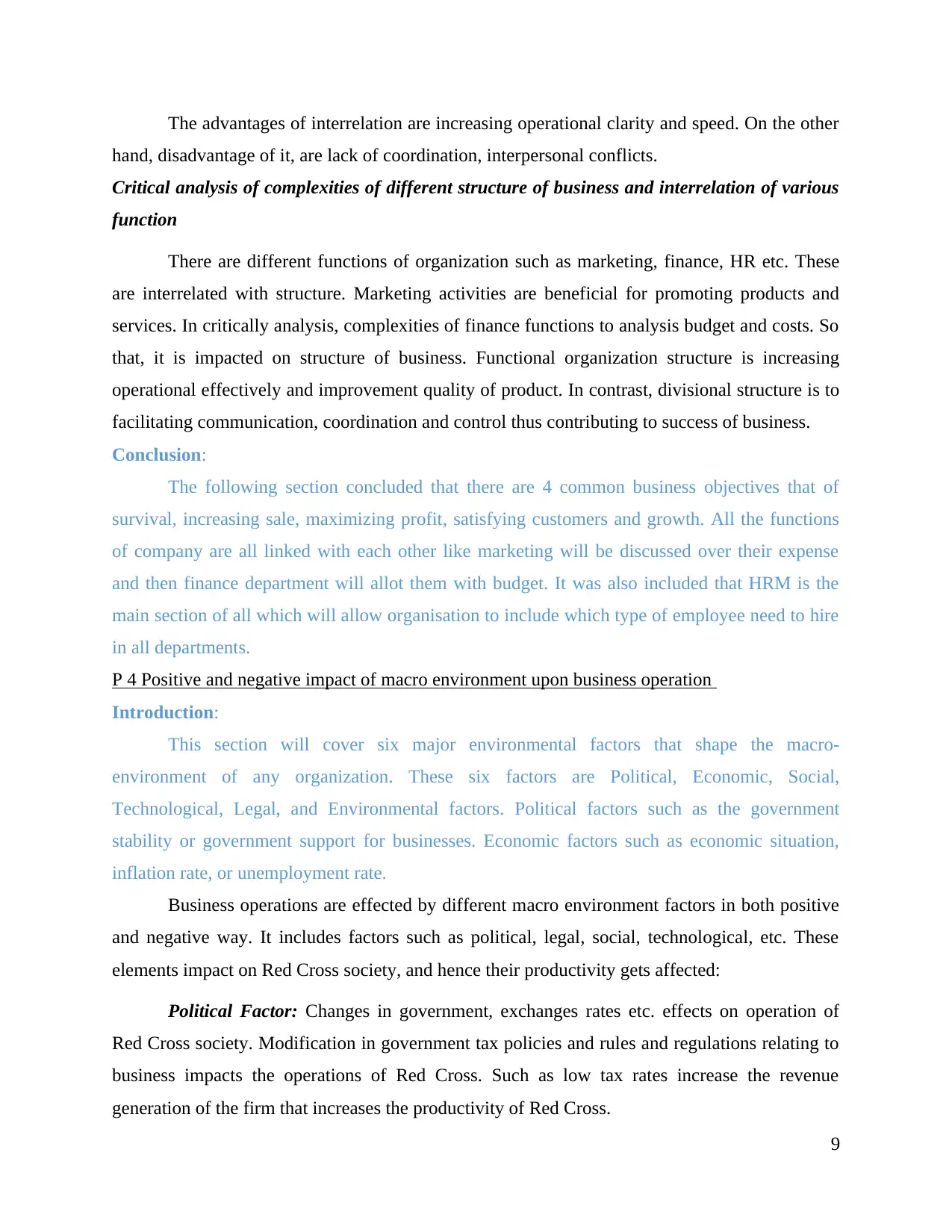
The advantages of interrelation are increasing operational clarity and speed. On the other
hand, disadvantage of it, are lack of coordination, interpersonal conflicts.
Critical analysis of complexities of different structure of business and interrelation of various
function
There are different functions of organization such as marketing, finance, HR etc. These
are interrelated with structure. Marketing activities are beneficial for promoting products and
services. In critically analysis, complexities of finance functions to analysis budget and costs. So
that, it is impacted on structure of business. Functional organization structure is increasing
operational effectively and improvement quality of product. In contrast, divisional structure is to
facilitating communication, coordination and control thus contributing to success of business.
Conclusion:
The following section concluded that there are 4 common business objectives that of
survival, increasing sale, maximizing profit, satisfying customers and growth. All the functions
of company are all linked with each other like marketing will be discussed over their expense
and then finance department will allot them with budget. It was also included that HRM is the
main section of all which will allow organisation to include which type of employee need to hire
in all departments.
P 4 Positive and negative impact of macro environment upon business operation
Introduction:
This section will cover six major environmental factors that shape the macro-
environment of any organization. These six factors are Political, Economic, Social,
Technological, Legal, and Environmental factors. Political factors such as the government
stability or government support for businesses. Economic factors such as economic situation,
inflation rate, or unemployment rate.
Business operations are effected by different macro environment factors in both positive
and negative way. It includes factors such as political, legal, social, technological, etc. These
elements impact on Red Cross society, and hence their productivity gets affected:
Political Factor: Changes in government, exchanges rates etc. effects on operation of
Red Cross society. Modification in government tax policies and rules and regulations relating to
business impacts the operations of Red Cross. Such as low tax rates increase the revenue
generation of the firm that increases the productivity of Red Cross.
9
hand, disadvantage of it, are lack of coordination, interpersonal conflicts.
Critical analysis of complexities of different structure of business and interrelation of various
function
There are different functions of organization such as marketing, finance, HR etc. These
are interrelated with structure. Marketing activities are beneficial for promoting products and
services. In critically analysis, complexities of finance functions to analysis budget and costs. So
that, it is impacted on structure of business. Functional organization structure is increasing
operational effectively and improvement quality of product. In contrast, divisional structure is to
facilitating communication, coordination and control thus contributing to success of business.
Conclusion:
The following section concluded that there are 4 common business objectives that of
survival, increasing sale, maximizing profit, satisfying customers and growth. All the functions
of company are all linked with each other like marketing will be discussed over their expense
and then finance department will allot them with budget. It was also included that HRM is the
main section of all which will allow organisation to include which type of employee need to hire
in all departments.
P 4 Positive and negative impact of macro environment upon business operation
Introduction:
This section will cover six major environmental factors that shape the macro-
environment of any organization. These six factors are Political, Economic, Social,
Technological, Legal, and Environmental factors. Political factors such as the government
stability or government support for businesses. Economic factors such as economic situation,
inflation rate, or unemployment rate.
Business operations are effected by different macro environment factors in both positive
and negative way. It includes factors such as political, legal, social, technological, etc. These
elements impact on Red Cross society, and hence their productivity gets affected:
Political Factor: Changes in government, exchanges rates etc. effects on operation of
Red Cross society. Modification in government tax policies and rules and regulations relating to
business impacts the operations of Red Cross. Such as low tax rates increase the revenue
generation of the firm that increases the productivity of Red Cross.
9
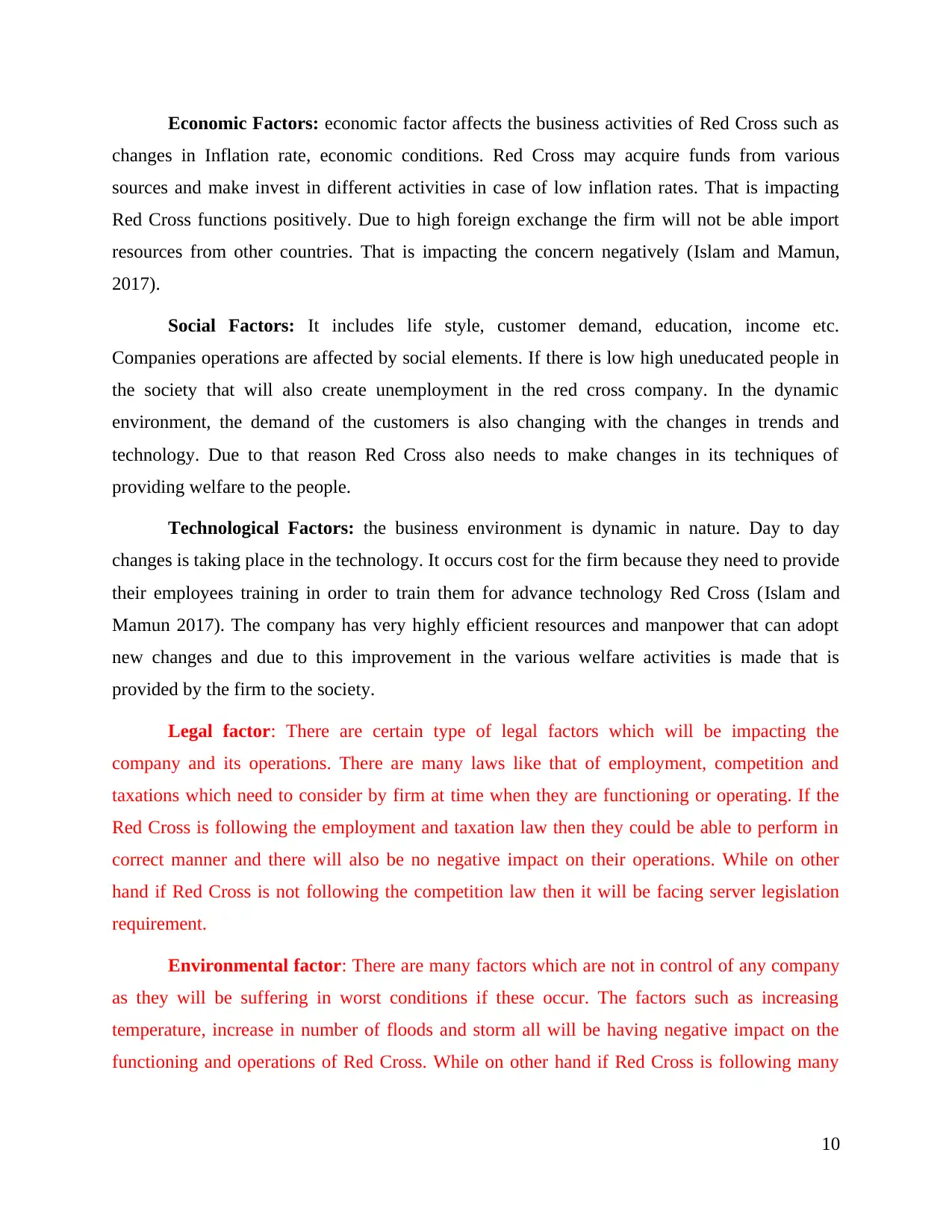
Economic Factors: economic factor affects the business activities of Red Cross such as
changes in Inflation rate, economic conditions. Red Cross may acquire funds from various
sources and make invest in different activities in case of low inflation rates. That is impacting
Red Cross functions positively. Due to high foreign exchange the firm will not be able import
resources from other countries. That is impacting the concern negatively (Islam and Mamun,
2017).
Social Factors: It includes life style, customer demand, education, income etc.
Companies operations are affected by social elements. If there is low high uneducated people in
the society that will also create unemployment in the red cross company. In the dynamic
environment, the demand of the customers is also changing with the changes in trends and
technology. Due to that reason Red Cross also needs to make changes in its techniques of
providing welfare to the people.
Technological Factors: the business environment is dynamic in nature. Day to day
changes is taking place in the technology. It occurs cost for the firm because they need to provide
their employees training in order to train them for advance technology Red Cross (Islam and
Mamun 2017). The company has very highly efficient resources and manpower that can adopt
new changes and due to this improvement in the various welfare activities is made that is
provided by the firm to the society.
Legal factor: There are certain type of legal factors which will be impacting the
company and its operations. There are many laws like that of employment, competition and
taxations which need to consider by firm at time when they are functioning or operating. If the
Red Cross is following the employment and taxation law then they could be able to perform in
correct manner and there will also be no negative impact on their operations. While on other
hand if Red Cross is not following the competition law then it will be facing server legislation
requirement.
Environmental factor: There are many factors which are not in control of any company
as they will be suffering in worst conditions if these occur. The factors such as increasing
temperature, increase in number of floods and storm all will be having negative impact on the
functioning and operations of Red Cross. While on other hand if Red Cross is following many
10
changes in Inflation rate, economic conditions. Red Cross may acquire funds from various
sources and make invest in different activities in case of low inflation rates. That is impacting
Red Cross functions positively. Due to high foreign exchange the firm will not be able import
resources from other countries. That is impacting the concern negatively (Islam and Mamun,
2017).
Social Factors: It includes life style, customer demand, education, income etc.
Companies operations are affected by social elements. If there is low high uneducated people in
the society that will also create unemployment in the red cross company. In the dynamic
environment, the demand of the customers is also changing with the changes in trends and
technology. Due to that reason Red Cross also needs to make changes in its techniques of
providing welfare to the people.
Technological Factors: the business environment is dynamic in nature. Day to day
changes is taking place in the technology. It occurs cost for the firm because they need to provide
their employees training in order to train them for advance technology Red Cross (Islam and
Mamun 2017). The company has very highly efficient resources and manpower that can adopt
new changes and due to this improvement in the various welfare activities is made that is
provided by the firm to the society.
Legal factor: There are certain type of legal factors which will be impacting the
company and its operations. There are many laws like that of employment, competition and
taxations which need to consider by firm at time when they are functioning or operating. If the
Red Cross is following the employment and taxation law then they could be able to perform in
correct manner and there will also be no negative impact on their operations. While on other
hand if Red Cross is not following the competition law then it will be facing server legislation
requirement.
Environmental factor: There are many factors which are not in control of any company
as they will be suffering in worst conditions if these occur. The factors such as increasing
temperature, increase in number of floods and storm all will be having negative impact on the
functioning and operations of Red Cross. While on other hand if Red Cross is following many
10
⊘ This is a preview!⊘
Do you want full access?
Subscribe today to unlock all pages.

Trusted by 1+ million students worldwide
1 out of 21
Related Documents
Your All-in-One AI-Powered Toolkit for Academic Success.
+13062052269
info@desklib.com
Available 24*7 on WhatsApp / Email
![[object Object]](/_next/static/media/star-bottom.7253800d.svg)
Unlock your academic potential
Copyright © 2020–2026 A2Z Services. All Rights Reserved. Developed and managed by ZUCOL.





![Business and Business Environment Analysis Report - [Course Name]](/_next/image/?url=https%3A%2F%2Fdesklib.com%2Fmedia%2Fimages%2Fsh%2F1f2b172c364e48c8beb7aaca2d402a17.jpg&w=256&q=75)